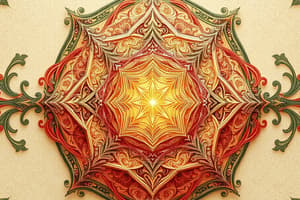Podcast
Questions and Answers
What is the primary characteristic of a rigid transformation?
What is the primary characteristic of a rigid transformation?
- It modifies the proportions of the image.
- It changes the shape of the preimage.
- It alters the color of the figure.
- It preserves both size and shape. (correct)
Which transformation is characterized by moving a figure a fixed distance in a specified direction?
Which transformation is characterized by moving a figure a fixed distance in a specified direction?
- Translation (correct)
- Rotation
- Reflection
- Dilation
In what type of transformation does a figure turn around a fixed point?
In what type of transformation does a figure turn around a fixed point?
- Translation
- Shear
- Reflection
- Rotation (correct)
What defines a reflection transformation?
What defines a reflection transformation?
How many types of isometries are identified in the content?
How many types of isometries are identified in the content?
What is a glide reflection?
What is a glide reflection?
What happens during a non-rigid transformation?
What happens during a non-rigid transformation?
Which transformation preserves size but may change orientation?
Which transformation preserves size but may change orientation?
What characteristic defines a cyclic rosette pattern?
What characteristic defines a cyclic rosette pattern?
Which type of symmetry is present in dihedral rosette patterns?
Which type of symmetry is present in dihedral rosette patterns?
What defines a frieze pattern in mathematics?
What defines a frieze pattern in mathematics?
Which of the following frieze patterns involves only translational symmetry?
Which of the following frieze patterns involves only translational symmetry?
What additional symmetry does the spinning hop pattern incorporate beyond translation?
What additional symmetry does the spinning hop pattern incorporate beyond translation?
Which frieze pattern is characterized by a reflection across a horizontal axis?
Which frieze pattern is characterized by a reflection across a horizontal axis?
Which symmetry types are present in the spinning jump frieze pattern?
Which symmetry types are present in the spinning jump frieze pattern?
What is the defining characteristic of the step frieze pattern?
What is the defining characteristic of the step frieze pattern?
What is a characteristic of non-rigid transformations?
What is a characteristic of non-rigid transformations?
Which statement about dilation is correct?
Which statement about dilation is correct?
How does shear transformation visually affect an image?
How does shear transformation visually affect an image?
What defines reflectional symmetry?
What defines reflectional symmetry?
What is true about rotational symmetry?
What is true about rotational symmetry?
Which type of symmetry involves shifting a pattern without changing its appearance?
Which type of symmetry involves shifting a pattern without changing its appearance?
Which of the following best describes a rosette pattern?
Which of the following best describes a rosette pattern?
What is Leonardo's Theorem associated with in geometric patterns?
What is Leonardo's Theorem associated with in geometric patterns?
What type of reflections are present in symmetry group 5?
What type of reflections are present in symmetry group 5?
Which of the following groups contains no glide reflections?
Which of the following groups contains no glide reflections?
What type of symmetries does the 'Sidle' pattern possess?
What type of symmetries does the 'Sidle' pattern possess?
Which symmetry group is characterized only by translations?
Which symmetry group is characterized only by translations?
What geometric shape is used for the fundamental region in symmetry group 6?
What geometric shape is used for the fundamental region in symmetry group 6?
What additional feature does symmetry group p2 have compared to symmetry group p1?
What additional feature does symmetry group p2 have compared to symmetry group p1?
In which symmetry group do the centers of rotations lie on the axes of reflection?
In which symmetry group do the centers of rotations lie on the axes of reflection?
Which symmetry group is characterized by the absence of rotations?
Which symmetry group is characterized by the absence of rotations?
Which type of symmetry is present in the 'Spinning sidle' pattern?
Which type of symmetry is present in the 'Spinning sidle' pattern?
In symmetry group 8, what type of symmetry is present aside from glide reflections?
In symmetry group 8, what type of symmetry is present aside from glide reflections?
In wallpaper patterns, what role does translation symmetry play?
In wallpaper patterns, what role does translation symmetry play?
What is the shape of the fundamental region for the symmetry group 5?
What is the shape of the fundamental region for the symmetry group 5?
How can wallpaper patterns be categorized?
How can wallpaper patterns be categorized?
What is the lattice structure of symmetry group p3?
What is the lattice structure of symmetry group p3?
How many axes of reflection does symmetry group 6 have?
How many axes of reflection does symmetry group 6 have?
What is the fundamental region for symmetry group p1?
What is the fundamental region for symmetry group p1?
Flashcards are hidden until you start studying
Study Notes
Transformations
- Transforming a geometric figure involves moving its points according to rules, creating a new figure called the image.
- A transformation establishes a correspondence between the points of the original figure and its image.
- Rigid transformations preserve the shape and size of the original figure.
- Non-rigid transformations change the size of the original figure, but not the shape.
Rigid Transformations (Isometries)
- Translations move a figure a fixed distance in a specific direction, keeping all points equidistant from their images.
- A translation vector indicates the distance and direction of the translation.
- Rotations turn a figure around a fixed center point by a specific angle, either clockwise or counterclockwise.
- Reflections flip a figure across a line of reflection, producing a mirror image. The line of reflection acts as a perpendicular bisector for segments joining points and their images.
- Glide reflections combine reflection and translation.
Non-Rigid Transformations
- Dilations expand or contract an object without changing its shape or orientation. This includes resizing, contraction, compression, enlargement, or expansion.
- Shearing "pushes" a side of the original shape while keeping a base fixed. Points move parallel to the fixed side in proportion to their distance from it.
Patterns and Diagrams
- Symmetry exists when an object can be divided into identical parts arranged in a specific pattern.
- Reflectional symmetry (mirror symmetry) occurs when half of an object is a reflection of the other half.
- Rotational symmetry involves rotating an object around an axis without altering its shape.
- Translational symmetry shifts a pattern or design from one location to another, maintaining the same orientation.
Rosette Patterns
- Rosette patterns are formed by rotating and/or reflecting a motif or element.
- Cyclic rosette patterns have rotational symmetry around a center point but no mirror lines.
- Dihedral rosette patterns possess both reflection and rotation symmetry around a center point, with mirror lines passing through the center.
Frieze Patterns
- Frieze patterns are repetitive designs on a two-dimensional surface, exhibiting translational symmetry in one direction.
- John Conway categorized frieze patterns based on their symmetries, using names like "hop," "step," "jump," "slide," "spinning hop," "spinning jump," and "spinning sidle."
Wallpaper Patterns
- Wallpaper patterns are repetitive designs covering a plane, exhibiting symmetries in multiple directions.
- Wallpaper patterns are categorized based on their symmetries.
- Symmetry group 1 (p1): Only translations, no reflections, glide reflections, or rotations.
- Symmetry group 2 (p2): Translations and 180° rotations, no reflections or glide reflections.
- Symmetry group 3 (pm): Reflections parallel to one translation axis and perpendicular to another.
- Symmetry group 4 (pg): Glide reflections parallel to one translation axis and perpendicular to another.
- Symmetry group 5 (cm): Reflections and glide reflections with parallel axes.
- Symmetry group 6 (pmm): Perpendicular axes of reflection, no glide reflections or rotations.
- Symmetry group 7 (pmg): Reflection and 180° rotations, centers of rotation not on reflection axes.
- Symmetry group 8 (pgg): Glide reflections with perpendicular axes and 180° rotations, centers of rotation not on reflection axes.
Studying That Suits You
Use AI to generate personalized quizzes and flashcards to suit your learning preferences.




